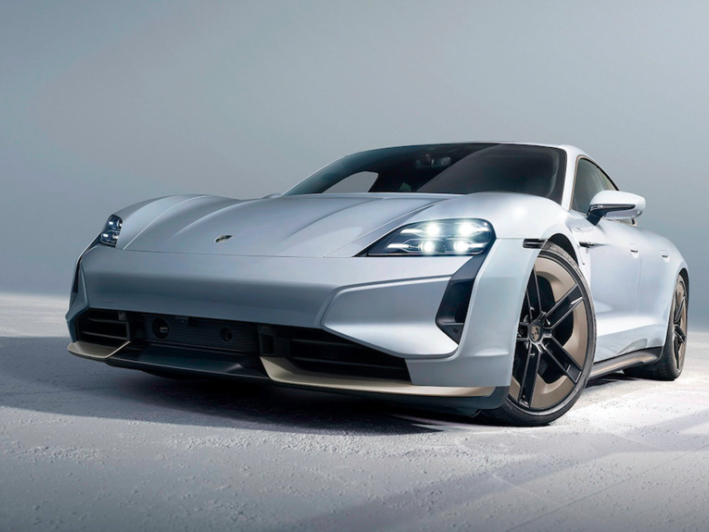Q
how much is a porsche taycan turbo
The price of the Porsche Taycan Turbo in Malaysia can vary depending on the configuration and market conditions. Generally, the price starts at around 905,000 Malaysian Ringgit or more. It's important to note that the actual price may fluctuate.
Special Disclaimer: This content is published by users and does not represent the views or position of PCauto.
Related Q&A
Q
How many seats in Porsche Taycan ?
The Porsche Taycan usually comes in configurations of 4 or 5 seats. However, the exact number of seats may vary depending on the model and configuration. Generally speaking, the common Taycan models are mostly 4-seaters.
Q
How long to charge the Porsche Taycan?
The charging time of the Porsche Taycan depends on several factors, including the power of the charging device and the remaining battery capacity. In Malaysia, the commonly used home AC charging station may take about 8 hours to fully charge. However, using a fast DC charging station will significantly shorten the charging time, generally about 30 minutes to charge the power to 80%.
Q
What is the top speed of a Porsche Taycan Turbo S?
The top speed of the Porsche Taycan Turbo S is typically about 260 kilometers per hour. However, the actual top speed may be affected by various factors such as road conditions, driving conditions, and the specific configuration of the vehicle.
Q
How much is a 2022 Porsche Taycan?
The price of the 2022 Porsche Taycan in Malaysia can vary due to different configurations and optional packages. Generally, the price ranges in the millions of ringgit. However, for the most accurate pricing, it is recommended to consult with your local Porsche dealer.
Q
Which model of Porsche Taycan has the longest range?
The range of different models of the Porsche Taycan can vary. Typically, the Taycan Turbo S has a relatively shorter range, while models like the Taycan 4S perform better under specific conditions. However, the exact range will be affected by various factors, such as driving habits, road conditions, and the environment. Generally speaking, Taycan models with better configurations and larger battery capacities have longer ranges.
Q
Which model of Porsche Taycan is the fastest?
The fastest model in the Porsche Taycan lineup is typically the Taycan Turbo S, which boasts exceptional performance and incredibly quick acceleration times. However, the vehicle's actual speed performance can be influenced by various factors such as road conditions and driving skills. Generally speaking, the Taycan Turbo S showcases astonishing high-speed capabilities.
Q
How far can a Porsche Taycan travel when fully charged?
The range of the Porsche Taycan can vary due to multiple factors. Common versions, when fully charged, have a range of approximately 400 to 500 kilometers. However, actual mileage can be affected by driving style, road conditions, temperature, and vehicle configuration, etc. In Malaysia, for example, the hot climate might affect the performance of the battery and thereby affect the endurance performance.
Q
How to charge a Porsche Taycan?
The Porsche Taycan offers several charging options. Users can opt for slow charging using a standard household power outlet, although this method is relatively slow. More commonly, dedicated charging stations are utilized, such as public fast chargers or home-installed charging points. In Malaysia, some commercial centers and parking lots are equipped with charging facilities. When charging, it's important to ensure a secure connection between the charging station and the vehicle, and to follow the operational instructions provided by the charging station. Additionally, keep an eye on the vehicle's charging status and duration to ensure both safety and efficiency during the charging process.
Q
When was Porsche Taycan released?
The Porsche Taycan was launched in 2019. This car also attracted considerable attention in the Malaysian market. With its excellent performance and innovative electric technology, it has become one of the important models in the field of high-end electric vehicles.
Q
How many kilowatt-hours does it take to charge a Porsche Taycan?
The charging capacity of the Porsche Taycan can vary depending on factors such as the model, battery capacity, and charging method. Generally speaking, the typical Porsche Taycan requires about 70 - 90 kWh of electricity to fully charge.
Latest Q&A
Q
How big is Myvi fuel tank?
As one of the most popular national cars in Malaysia, the fuel tank capacity of the Perodua Myvi varies according to different generations and versions. The standard fuel tank capacity of the current third - generation Myvi (from 2017 to present) is 36 liters. It features a lightweight resin fuel tank design, which balances the fuel storage needs and the vehicle's body weight.
The fuel tank size of this B - segment model matches the fuel economy of its 1.3L/1.5L engines. It can provide a cruising range of approximately 450 - 550 kilometers under combined driving conditions, making it suitable for urban commuting and short - distance trips. It's worth noting that the actual available fuel tank capacity might be slightly less than the nominal value. This is because about 5% of the tank space is reserved for fuel expansion as a safety measure.
For owners planning long - distance drives, it is recommended to use the fuel efficiency display function on the Myvi's dashboard to monitor fuel consumption in real - time. Also, it's advisable to develop the habit of refueling when the fuel gauge shows that there is about 1/4 of the fuel left. This can prevent the fuel pump from overheating and also help deal with the situation where gas stations are far apart in some remote areas of Malaysia.
Some comparable models in the same segment, like the Proton Iriz, have a 40 - liter fuel tank. However, the actual cruising range needs to be considered in combination with the engine efficiency. Thanks to Perodua's mature powertrain tuning, the Myvi always maintains a competitive edge in terms of fuel economy.
Q
Does Myvi use CVT?
Yes, the Perodua Myvi does use CVT (Continuously Variable Transmission) technology in some models, especially the newer ones. For instance, the third-generation Myvi, launched in 2017, and its subsequent versions are equipped with D-CVT (Dual Mode Continuously Variable Transmission) to offer a smoother driving experience and better fuel efficiency. CVT technology optimizes engine performance through continuously variable gear ratios. Compared with traditional automatic transmissions, it can adapt to driving conditions more flexibly, thereby enhancing overall driving comfort. However, earlier Myvi models may have used a traditional 4-speed automatic transmission. So, whether a specific model is equipped with a CVT needs to be confirmed based on the model year and configuration. For Malaysian consumers, the advantages of CVT lie in its smoothness and fuel - saving performance during city driving, which is very suitable for the common local traffic conditions. But if you're looking for more direct power feedback, some drivers may prefer the manual transmission version. If you're considering buying a Myvi, it's recommended to check the official specifications or consult a dealer to confirm the transmission type. You can also take a test drive to see if the actual performance of the CVT meets your driving preferences.
Q
What kind of gearbox is Myvi?
The Myvi is equipped with a Dual Mode CVT (D-CVT) transmission, which is a dual-mode continuously variable transmission. Compared with traditional CVT transmissions, it has an additional gear for high-speed driving, which helps the vehicle achieve better fuel efficiency.
In daily driving, this transmission drives the vehicle in CVT mode. Thanks to the operation of the steel belt, the vehicle moves smoothly and linearly, enhancing comfort. What makes the D-CVT special is that it automatically switches to the gear mode when driving at high speeds. Different from CVT transmissions of other brands, when driving at high speeds, the engine speed of vehicles with ordinary CVT transmissions will increase, the engine noise will get louder, and the fuel consumption will rise. Moreover, the power will decline after exceeding the maximum horsepower speed. However, after the gear of the D-CVT engages, the engine speed decreases, allowing the engine to maintain a reasonable speed and providing the vehicle with continuous and abundant power.
Q
Are Myvi and vios the same engine?
Some models of the Myvi and the Vios use the same engine. Daihatsu and Perodua have a joint - venture engine production plant in Negeri Sembilan, Malaysia, which provides power for multiple models including the Vios. Some models of the Vios and the Myvi are equipped with the 1.5L Dual VVT - i engine. This engine features high efficiency, reliability, and economy. Although its power is not extremely strong (the official 0 - 100km/h acceleration time of the Myvi 1.5 is 10.2 seconds), its low fuel consumption and durability are well - loved by consumers. However, these two cars have different positioning and market targets. Even if they share the engine platform, there are differences in vehicle tuning, configuration, and the overall driving experience.
Q
How many cylinders are in the MYVI?
As one of the most popular national cars in Malaysia, the engine configurations of the Perodua Myvi vary according to different years and versions. Currently, the mainstream models are equipped with two types of Dual VVT - i four - cylinder naturally aspirated engines, namely the 1.3L (1NR - VE) and 1.5L (2NR - VE). Therefore, all Myvi models feature a four - cylinder design. This four - cylinder layout ensures smooth power delivery while taking fuel economy into account, making it highly suitable for the urban road conditions in Malaysia.
It's worth mentioning that four - cylinder engines, due to their simple structure and low maintenance costs, are widely used in B - segment models in the local market. For example, the Proton Saga and Honda City also adopt a similar layout. The 1.5L version of the Myvi can output 102 horsepower and 136 Nm of torque. Coupled with its lightweight body design, it can offer a well - balanced performance whether driving on the congested streets of Kuala Lumpur or cruising on the highway.
For readers who want to learn about engine technology, they can note that the Dual VVT - i system used in the Myvi can intelligently adjust the valve timing. This technology shared by Toyota helps to improve fuel efficiency by about 15%. That's why the Myvi has remained one of the most fuel - efficient cars in Malaysia for years.
View MoreRelated News

Xiaomi SU7 Ultra priced at RM32,000, plans to sell globally in 2027
Kevin WongMar 5, 2025

2024 Porsche Taycan officially released, prices start from RM 575,000
LienJun 20, 2024

Porsche releases the all-new track weapons 911 Cup and GT3 R
LienAug 11, 2025

All-New Porsche 911 Turbo S to Debut in 2025 with First-Ever Hybrid System, Targeting Over 700 hp
RobertAug 4, 2025

Porsche Tests Second-Gen Cayenne Electric, Aims to Rival Model X
JohnJul 16, 2025
View More


















Pros
Cons